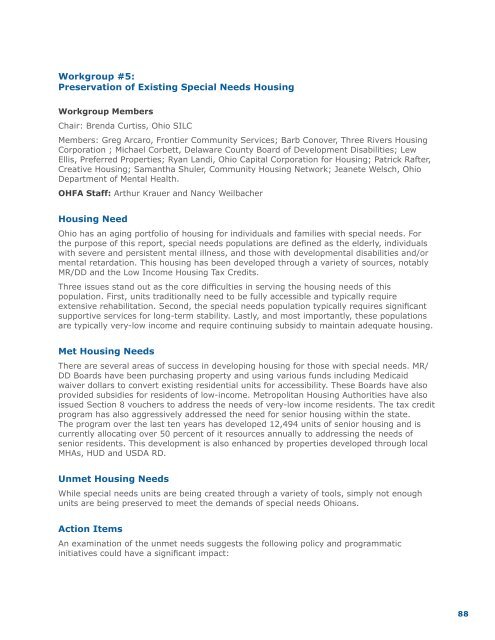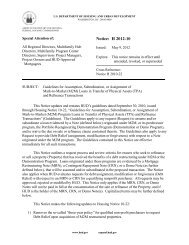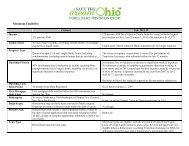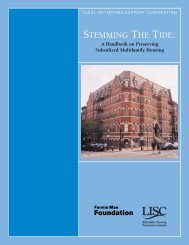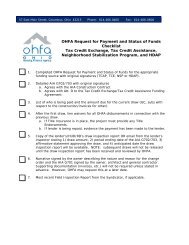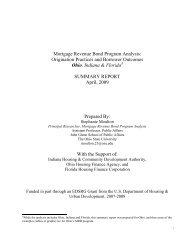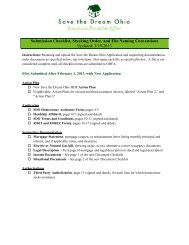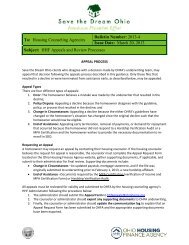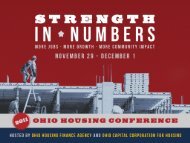OHFA Annual Plan - Ohio Housing Finance Agency
OHFA Annual Plan - Ohio Housing Finance Agency
OHFA Annual Plan - Ohio Housing Finance Agency
You also want an ePaper? Increase the reach of your titles
YUMPU automatically turns print PDFs into web optimized ePapers that Google loves.
Workgroup #5:Preservation of Existing Special Needs <strong>Housing</strong>Workgroup MembersChair: Brenda Curtiss, <strong>Ohio</strong> SILCMembers: Greg Arcaro, Frontier Community Services; Barb Conover, Three Rivers <strong>Housing</strong>Corporation ; Michael Corbett, Delaware County Board of Development Disabilities; LewEllis, Preferred Properties; Ryan Landi, <strong>Ohio</strong> Capital Corporation for <strong>Housing</strong>; Patrick Rafter,Creative <strong>Housing</strong>; Samantha Shuler, Community <strong>Housing</strong> Network; Jeanete Welsch, <strong>Ohio</strong>Department of Mental Health.<strong>OHFA</strong> Staff: Arthur Krauer and Nancy Weilbacher<strong>Housing</strong> Need<strong>Ohio</strong> has an aging portfolio of housing for individuals and families with special needs. Forthe purpose of this report, special needs populations are defined as the elderly, individualswith severe and persistent mental illness, and those with developmental disabilities and/ormental retardation. This housing has been developed through a variety of sources, notablyMR/DD and the Low Income <strong>Housing</strong> Tax Credits.Three issues stand out as the core difficulties in serving the housing needs of thispopulation. First, units traditionally need to be fully accessible and typically requireextensive rehabilitation. Second, the special needs population typically requires significantsupportive services for long-term stability. Lastly, and most importantly, these populationsare typically very-low income and require continuing subsidy to maintain adequate housing.Met <strong>Housing</strong> NeedsThere are several areas of success in developing housing for those with special needs. MR/DD Boards have been purchasing property and using various funds including Medicaidwaiver dollars to convert existing residential units for accessibility. These Boards have alsoprovided subsidies for residents of low-income. Metropolitan <strong>Housing</strong> Authorities have alsoissued Section 8 vouchers to address the needs of very-low income residents. The tax creditprogram has also aggressively addressed the need for senior housing within the state.The program over the last ten years has developed 12,494 units of senior housing and iscurrently allocating over 50 percent of it resources annually to addressing the needs ofsenior residents. This development is also enhanced by properties developed through localMHAs, HUD and USDA RD.Unmet <strong>Housing</strong> NeedsWhile special needs units are being created through a variety of tools, simply not enoughunits are being preserved to meet the demands of special needs <strong>Ohio</strong>ans.Action ItemsAn examination of the unmet needs suggests the following policy and programmaticinitiatives could have a significant impact:88


